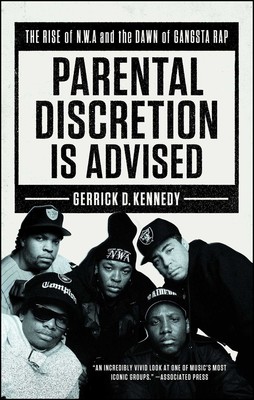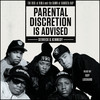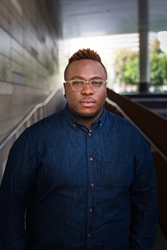Plus get our latest book recommendations, author news, and competitions right to your inbox.
Table of Contents
About The Book
Experience the stunning rise, fall, and legacy of N.W.A. and how they put their stamp on pop culture, black culture, and hip-hop music forever in this “incredibly vivid look at one of music’s most iconic groups” (Associated Press).
In 1986, a group was formed that would establish the foundation of gangsta rap and push the genre forward, electrifying fans with their visceral and profane lyrics that glorified the dark ways of street life and brazenly challenged the police system.
Eazy-E, Dr. Dre, Ice Cube, MC Ren, and DJ Yella caused a seismic shift in hip-hop when they decided to form N.W.A in 1986. With their hard-core image, bombastic sound, and lyrics that were equal parts poetic, lascivious, conscious, and downright in-your-face, N.W.A spoke the truth about life on the streets of Compton, California—then a hotbed of poverty, drugs, gangs, and unemployment.
Going beyond the story portrayed in the 2015 blockbuster movie Straight Outta Compton, through firsthand interviews, extensive research, and top-notch storytelling, Los Angeles Times music reporter Gerrick Kennedy transports you back in time and offers a front-row seat to N.W.A’s early days and the drama and controversy that followed the incendiary group as they rose to become multiplatinum artists.
Kennedy leaves nothing off the table in his pursuit of the full story behind the group’s most pivotal moments, such as Ice Cube’s decision to go solo after their debut studio album became a smash hit; their battle with the FBI over inflammatory lyrics; incidents of physical assault; Dr. Dre’s departure from the group to form Death Row Records with Suge Knight; their impact on the 1992 L.A. riots; Eazy-E’s battle with AIDS; and much more.
A bold, riveting, “non-stop, can’t-put-it-down ride” (Library Journal), Parental Discretion Is Advised unveils the true and astonishing history of one of the most transcendent and controversial musical groups of the 1980s and 1990s.
In 1986, a group was formed that would establish the foundation of gangsta rap and push the genre forward, electrifying fans with their visceral and profane lyrics that glorified the dark ways of street life and brazenly challenged the police system.
Eazy-E, Dr. Dre, Ice Cube, MC Ren, and DJ Yella caused a seismic shift in hip-hop when they decided to form N.W.A in 1986. With their hard-core image, bombastic sound, and lyrics that were equal parts poetic, lascivious, conscious, and downright in-your-face, N.W.A spoke the truth about life on the streets of Compton, California—then a hotbed of poverty, drugs, gangs, and unemployment.
Going beyond the story portrayed in the 2015 blockbuster movie Straight Outta Compton, through firsthand interviews, extensive research, and top-notch storytelling, Los Angeles Times music reporter Gerrick Kennedy transports you back in time and offers a front-row seat to N.W.A’s early days and the drama and controversy that followed the incendiary group as they rose to become multiplatinum artists.
Kennedy leaves nothing off the table in his pursuit of the full story behind the group’s most pivotal moments, such as Ice Cube’s decision to go solo after their debut studio album became a smash hit; their battle with the FBI over inflammatory lyrics; incidents of physical assault; Dr. Dre’s departure from the group to form Death Row Records with Suge Knight; their impact on the 1992 L.A. riots; Eazy-E’s battle with AIDS; and much more.
A bold, riveting, “non-stop, can’t-put-it-down ride” (Library Journal), Parental Discretion Is Advised unveils the true and astonishing history of one of the most transcendent and controversial musical groups of the 1980s and 1990s.
Excerpt
Parental Discretion Is Advised PROLOGUE
SEPTEMBER 07, 2013 * SAN BERNARDINO, CALIFORNIA
A maze of metal barricades was stuffed with hundreds of rap fans waiting to file into San Manuel Amphitheater. Inside, heavy, pounding bass from the DJ’s turntable drowned out the piercing beeps of metal detectors that greeted early arrivers. It was opening day of Rock the Bells, an annual hip-hop festival that was launched in Southern California and toured throughout the world during its decade run. Twenty thousand fans made the pilgrimage to the hills of the Inland Empire desert, roughly an hour and a half outside of Los Angeles, for two days of music performances. The mix of underground genre outliers; revered elder statesmen; and young, chart-topping wunderkinds allowed Rock the Bells to enjoy a status as the preeminent destination for hip-hop fans well before massive music gatherings like Coachella, Bonnaroo, and Lollapalooza diversified their lineups to reflect rap’s surging mainstream dominance. A gust of wind swept dust through the security line as workers confiscated prohibited paraphernalia from disappointed fans who unsuccessfully hid marijuana blunts or glass one-hitters they hoped to bring into the festival. It was well over 100 degrees on this Saturday afternoon, but more palpable than the triple-digit temperature was the anticipation from fans waiting to get inside.
The bill was a heady, extensive representation of several generations of hip-hop acts that traversed mainstream and alternative lanes of the genre. Common; Jurassic 5; Kid Cudi; Pusha T; KRS-One; Talib Kweli; Kendrick Lamar; Tech N9ne; Earl Sweatshirt; Slick Rick; Juicy J; Too Short; Immortal Technique; E-40; Tyler, the Creator; Doug E. Fresh; Lecrae; J. Cole; Rakim; A$AP Rocky; Danny Brown; the Internet; and Wu-Tang Clan were all booked for a weekend that marked the landmark tenth anniversary of the festival.
Also on the marquee was Eazy-E, the “Godfather of Gangsta rap” and founder of the most notorious hip-hop group of all time, N.W.A.
Nearly two decades had passed since Eazy took his last breath, losing his battle with AIDS years after N.W.A crumbled amid accusations of shady contracts and bitter rivalries. Eazy was long expunged from the narrative of hip-hop, succumbing to the mores of irrelevance after his hard-core image morphed into a sort of zany caricature of itself. But today he would rap again.
In the months leading up to the festival, Rezin8, a San Diego–based company that specializes in immersive design, was hard at work resurrecting Eazy. A combination of green-screen motion capture, animation, multimedia, and Eazy’s children’s memories produced what was hyped as an “accurate, authentic reflection” of the rapper. Eric “Lil Eazy-E” Wright Jr. was used for the avatar’s body. Derrek “E3” Wright provided the voice. And Eazy’s “face” was constructed using an imprint of his daughter, Ebie Wright.
“You’re not going to be looking at 1987 Eazy-E, you’re going to be looking at 1994 heyday,” Eazy-E’s widow, Tomica Woods-Wright, said ahead of the festival. “You’re going to get probably what most people remember of that last impression of that era he was in.”
“We aren’t trying to mimic something, you’re creating something,” Wright continued. “We’re building, in the capacity, a reflection to carry on that’s a piece of him. It’s not going to be him, but it’s going to be as damn close as you can get.”
On what would have been Eazy’s fiftieth birthday, the technology that brought Tupac Shakur, Ol’ Dirty Bastard, and Michael Jackson back from the dead for another musical thrill introduced Eazy’s digitized likeness for a “virtual performance” (as it was billed by the festival organizers).
A dozen incandescent bulbs cast a blue glow over the stage as plumes of dank marijuana smoke hung over the audience. Despite years of beef among the group, Bone Thugs-N-Harmony, the Cleveland rap posse Eazy signed to his Ruthless Records, reunited for the occasion and had just performed a set of its biggest hits when the lights came to a slow dim. From the amphitheater’s rafters, a complex rig descended slowly as multiple smoke machines sent thick clouds of fog, pale red from a strip of lights, rolling across the stage. With the push of a button, there he was again, clad in his signature slate-gray Dickies that sagged slightly and a black hat with “Compton” stitched in white, Old English–font letters.
Eazy—or, more accurately, the digital composition of him—stood still, soaking up the rapturous applause from the crowd.
“We Want Eazy! We Want Eazy! We Want Eazy!” the crowd cheered.
When his former bandmate DJ Yella, behind a pair of turntables, cued up a beat as startling as an air-raid siren, Eazy started bobbing his head to the music and finding his swagger before addressing the crowd, many of whom hoisted smartphones in the air to record the moment. There were even gasps of disbelief as one of rap’s earliest fallen heroes was resurrected.
“What’s up, LA! Make some motherfucking noise,” digital Eazy shouted.
Satisfied with the love he was receiving, Eazy launched into the verse that caps one of the most famous rap songs of all time, a record that transformed the genre forever.
“. . . Straight outta Compton is a brotha that’ll smother yo’ mother,” Eazy rapped amid the shrills of twenty thousand rap heads. An overwhelming number of Compton hats and T-shirts emblazoned with “N.W.A” in eerie red letters—or ones with the faces of its members in mug shot–like poses—could be seen in the audience. Throughout the weekend, Eazy’s face was omnipresent, as scores of savvy street vendors camping out in the parking lot sold an array of homemade N.W.A paraphernalia for well below what merchants inside charged. Eazy would have appreciated the hustle.
“Dangerous motherfucker raises hell, and if I ever get caught I make bail,” Eazy continued as his holographic likeness bounced alongside DJ Yella without missing a beat.
Without as much as a pause, Eazy then dove into another of his indelible, hard-core tales of street life, “Boyz-n-the-Hood”—a song that transformed the former drug dealer into an unlikely rap sensation. The crowd, some of whom were not even alive during the peak of Eazy’s fame, joined in unison to chant the anthem’s most famous bars:
Cruisin’ down the street in my six-fo’
Jockin’ the bitches, slappin’ the hoes
For a moment Eazy was alive again, basking in the love that has largely evaded him since his death, as his legacy is often overlooked in the pantheon of fallen rap gods. Unlike Tupac and the Notorious B.I.G., he didn’t go out a hip-hop martyr consumed by the violent street life dominant in his lyrics. But like his life and his career, Eazy’s moment onstage was all too brief. Just as quickly as he had arrived, he vanished into a cloud of smoke. And the show went on.
SEPTEMBER 07, 2013 * SAN BERNARDINO, CALIFORNIA
A maze of metal barricades was stuffed with hundreds of rap fans waiting to file into San Manuel Amphitheater. Inside, heavy, pounding bass from the DJ’s turntable drowned out the piercing beeps of metal detectors that greeted early arrivers. It was opening day of Rock the Bells, an annual hip-hop festival that was launched in Southern California and toured throughout the world during its decade run. Twenty thousand fans made the pilgrimage to the hills of the Inland Empire desert, roughly an hour and a half outside of Los Angeles, for two days of music performances. The mix of underground genre outliers; revered elder statesmen; and young, chart-topping wunderkinds allowed Rock the Bells to enjoy a status as the preeminent destination for hip-hop fans well before massive music gatherings like Coachella, Bonnaroo, and Lollapalooza diversified their lineups to reflect rap’s surging mainstream dominance. A gust of wind swept dust through the security line as workers confiscated prohibited paraphernalia from disappointed fans who unsuccessfully hid marijuana blunts or glass one-hitters they hoped to bring into the festival. It was well over 100 degrees on this Saturday afternoon, but more palpable than the triple-digit temperature was the anticipation from fans waiting to get inside.
The bill was a heady, extensive representation of several generations of hip-hop acts that traversed mainstream and alternative lanes of the genre. Common; Jurassic 5; Kid Cudi; Pusha T; KRS-One; Talib Kweli; Kendrick Lamar; Tech N9ne; Earl Sweatshirt; Slick Rick; Juicy J; Too Short; Immortal Technique; E-40; Tyler, the Creator; Doug E. Fresh; Lecrae; J. Cole; Rakim; A$AP Rocky; Danny Brown; the Internet; and Wu-Tang Clan were all booked for a weekend that marked the landmark tenth anniversary of the festival.
Also on the marquee was Eazy-E, the “Godfather of Gangsta rap” and founder of the most notorious hip-hop group of all time, N.W.A.
Nearly two decades had passed since Eazy took his last breath, losing his battle with AIDS years after N.W.A crumbled amid accusations of shady contracts and bitter rivalries. Eazy was long expunged from the narrative of hip-hop, succumbing to the mores of irrelevance after his hard-core image morphed into a sort of zany caricature of itself. But today he would rap again.
In the months leading up to the festival, Rezin8, a San Diego–based company that specializes in immersive design, was hard at work resurrecting Eazy. A combination of green-screen motion capture, animation, multimedia, and Eazy’s children’s memories produced what was hyped as an “accurate, authentic reflection” of the rapper. Eric “Lil Eazy-E” Wright Jr. was used for the avatar’s body. Derrek “E3” Wright provided the voice. And Eazy’s “face” was constructed using an imprint of his daughter, Ebie Wright.
“You’re not going to be looking at 1987 Eazy-E, you’re going to be looking at 1994 heyday,” Eazy-E’s widow, Tomica Woods-Wright, said ahead of the festival. “You’re going to get probably what most people remember of that last impression of that era he was in.”
“We aren’t trying to mimic something, you’re creating something,” Wright continued. “We’re building, in the capacity, a reflection to carry on that’s a piece of him. It’s not going to be him, but it’s going to be as damn close as you can get.”
On what would have been Eazy’s fiftieth birthday, the technology that brought Tupac Shakur, Ol’ Dirty Bastard, and Michael Jackson back from the dead for another musical thrill introduced Eazy’s digitized likeness for a “virtual performance” (as it was billed by the festival organizers).
A dozen incandescent bulbs cast a blue glow over the stage as plumes of dank marijuana smoke hung over the audience. Despite years of beef among the group, Bone Thugs-N-Harmony, the Cleveland rap posse Eazy signed to his Ruthless Records, reunited for the occasion and had just performed a set of its biggest hits when the lights came to a slow dim. From the amphitheater’s rafters, a complex rig descended slowly as multiple smoke machines sent thick clouds of fog, pale red from a strip of lights, rolling across the stage. With the push of a button, there he was again, clad in his signature slate-gray Dickies that sagged slightly and a black hat with “Compton” stitched in white, Old English–font letters.
Eazy—or, more accurately, the digital composition of him—stood still, soaking up the rapturous applause from the crowd.
“We Want Eazy! We Want Eazy! We Want Eazy!” the crowd cheered.
When his former bandmate DJ Yella, behind a pair of turntables, cued up a beat as startling as an air-raid siren, Eazy started bobbing his head to the music and finding his swagger before addressing the crowd, many of whom hoisted smartphones in the air to record the moment. There were even gasps of disbelief as one of rap’s earliest fallen heroes was resurrected.
“What’s up, LA! Make some motherfucking noise,” digital Eazy shouted.
Satisfied with the love he was receiving, Eazy launched into the verse that caps one of the most famous rap songs of all time, a record that transformed the genre forever.
“. . . Straight outta Compton is a brotha that’ll smother yo’ mother,” Eazy rapped amid the shrills of twenty thousand rap heads. An overwhelming number of Compton hats and T-shirts emblazoned with “N.W.A” in eerie red letters—or ones with the faces of its members in mug shot–like poses—could be seen in the audience. Throughout the weekend, Eazy’s face was omnipresent, as scores of savvy street vendors camping out in the parking lot sold an array of homemade N.W.A paraphernalia for well below what merchants inside charged. Eazy would have appreciated the hustle.
“Dangerous motherfucker raises hell, and if I ever get caught I make bail,” Eazy continued as his holographic likeness bounced alongside DJ Yella without missing a beat.
Without as much as a pause, Eazy then dove into another of his indelible, hard-core tales of street life, “Boyz-n-the-Hood”—a song that transformed the former drug dealer into an unlikely rap sensation. The crowd, some of whom were not even alive during the peak of Eazy’s fame, joined in unison to chant the anthem’s most famous bars:
Cruisin’ down the street in my six-fo’
Jockin’ the bitches, slappin’ the hoes
For a moment Eazy was alive again, basking in the love that has largely evaded him since his death, as his legacy is often overlooked in the pantheon of fallen rap gods. Unlike Tupac and the Notorious B.I.G., he didn’t go out a hip-hop martyr consumed by the violent street life dominant in his lyrics. But like his life and his career, Eazy’s moment onstage was all too brief. Just as quickly as he had arrived, he vanished into a cloud of smoke. And the show went on.
Product Details
- Publisher: Atria Books (October 1, 2018)
- Length: 296 pages
- ISBN13: 9781501134920
Browse Related Books
Raves and Reviews
“An incredibly vivid look at one of music’s most iconic groups.” (Associated Press)
"Kennedy pieces together N.W.A’s downfall with an informed precision.” (Los Angeles Times)
“A nonstop, can't-put-it down ride.” (Library Journal)
"An apt consideration of a raunchy yet vital cultural moment." (Kirkus)
“In-depth portrait of a seminal group.” (Booklist)
“An entertaining account.” (Kirkus Reviews)
Resources and Downloads
High Resolution Images
- Book Cover Image (jpg): Parental Discretion Is Advised Trade Paperback 9781501134920
- Author Photo (jpg): Gerrick D. Kennedy Photograph by Andres Tardio(0.1 MB)
Any use of an author photo must include its respective photo credit







